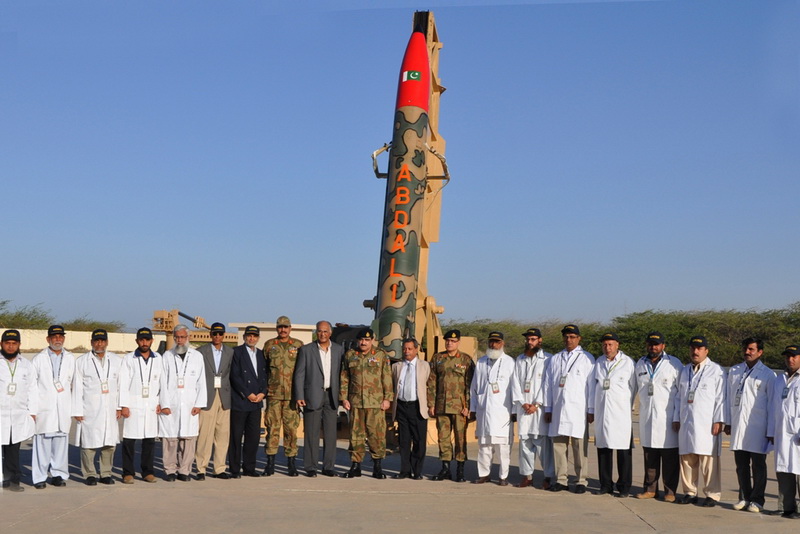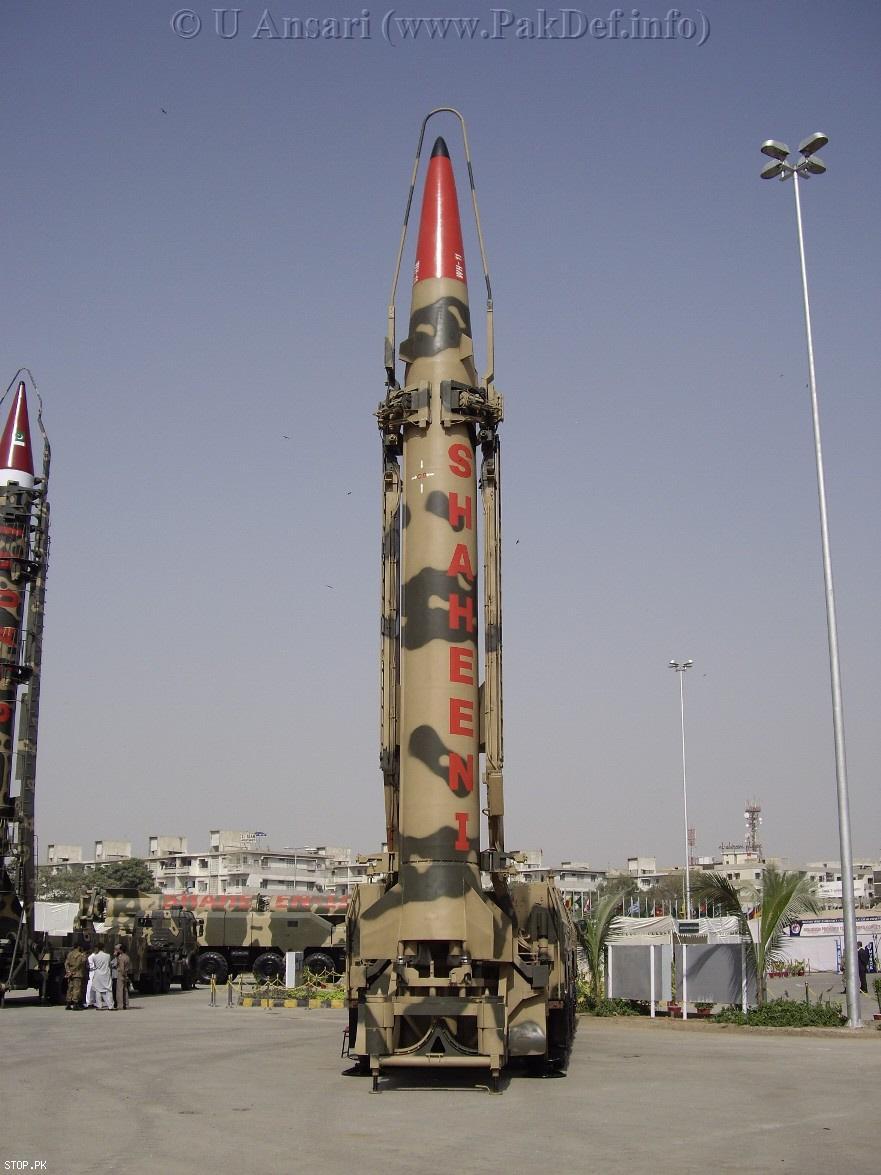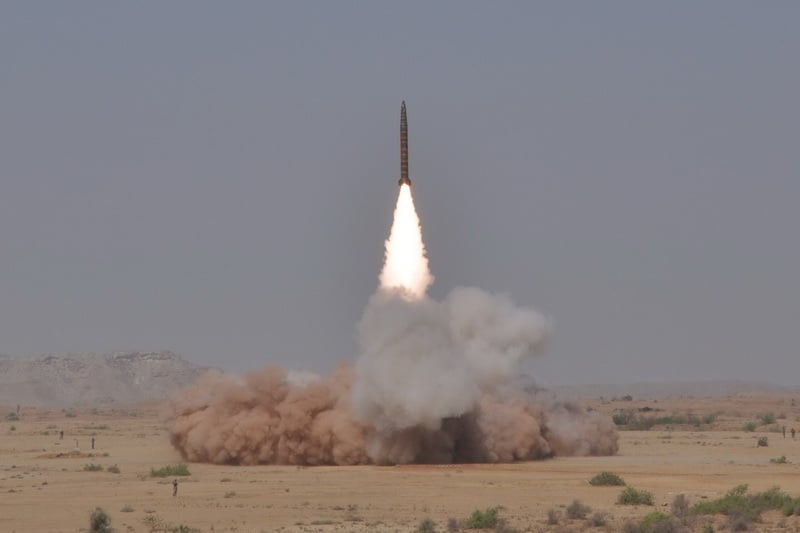The Deterrent
SENIOR MEMBER

- Joined
- Jan 7, 2011
- Messages
- 3,168
- Reaction score
- 39
- Country
- Location
Pakistani Ballistic Missiles : How much Pakistani are they?
"Defense is the right of every country.And the credible capability to defend or deter an enemy attack should be achieved,by any available means."
There have been many foreign reports,which claim Pakistani Ballistic missiles to be simply "copies" of Chinese and North Korean missiles.Unfortunately,most of the people (foreigners) believe such reports blindly and accuse Pakistan of only performing the "Paint job".This article is intended to remove those confusions,and pin-point the developments made by Pakistan.However,there is no doubt that the very basic origins of the ballistic missiles of Pakistan lie in China and North Korea.
In the following paras,we will see all of them one by one.
Hatf-1 /Hatf-1A /Hatf-1B BRBM (Range 70-100km,Warhead Payload 500 kg)
Development History :
Hatf-1 was developed by SUPARCO and was first tested in March,1989.By that time SUPARCO had achieved significant expertise,because it had been developing and launching Solid-fueled sounding rockets since the 1970s.Hatf-1 had a poor accuracy(400-500 m CEP),with a very simple INS and a range of 70 km.
Origins :
It was based on the French Dauphin Sounding Rocket.But contrary to Dauphin,Hatf-1 was an Artillery Rocket launched at an angle.Notable differences between the two systems include:
Aerodynamic tail fins on Hatf-1
Altitude of 50km approx (150 km of Dauphin)
500 kg payload (150 kg of Dauphin)
1500 kg launch weight (1132 kg of Dauphin)
Length 6.0m (6.21m of Dauphin)
However,the diameter of both systems was same,i.e. 0.56m.
French Dauphin Sounding Rocket:

Pakistani Hatf-1 Ballistic Missile:

What Pakistan did :
In two years,Hatf-1 underwent an upgrade.The upgraded version was named Hatf-1A.It had an increased range of 100 km with increased accuracy.
Later on,another upgrade was made to Hatf-1A.This time,its accuracy was further improved by adding an advanced INS which was made from the experienced gained during the development of other projects.Thus the CEP was decreased to 10-15 m.It was tested in 2000,and was designated Hatf-1B as a Guided Ballistic Missile.
As of now,all previous Hatf-1 versions have been completely replaced by Hatf-1B.
So,Hatf-1 is this much Pakistani :
1. Modified aerodynamic (chopped) tail fins.
2. Locally developed launch rail supported on a towed platform.
3. Powerful Motor installed on Hatf-1A,increasing its range by 30 km.
4. A simple INS integrated on Hatf-1A,reducing the CEP to 100 m.
5. An advanced INS integrated on Hatf-1B,further reducing its CEP to 15 m.
In effect,Pakistan transformed a sounding rocket into a Guided Ballistic Missile.
Hatf-2 Shadoz SRBM (Range 300 km,Warhead Payload 500 kg) "Cancelled"
Development History :
Initially,Hatf-2 had the name of "Shadoz".It was developed by SUPARCO and was tested in 1989.
Its accuracy was poor,relative to the newer Abdali.
Origins :
The first Hatf-2 was a two-stage version of the Hatf-1.It was based on the two stage French Sounding Rocket Eridan.It bore somewhat the same relative differences from Eridan,as Hatf-1 did from Dauphen.
Later,the project was terminated,in favor of the more advanced M-11 missiles.
French Eridan Sounding Rocket:

Pakistani Hatf-2 Shadoz Ballistic Missile:

What Pakistan did :
It is clear that Hatf-2 Shadoz was heavily based on Eridan.But,it was this much Pakistani :
1. Modified aerodynamic (chopped) tail and second stage fins.
2. Locally developed launch rail supported on a towed platform.
3. A simple INS installed,giving a CEP of ~200 m.
French Dragon (background),Centaure (middle) and Belier (foreground) Sounding Rockets

Note : Though the Centaure and Belier appear similar to preious Hatf-I and II,they were smaller in dimensions.
Diagram of Initial Pakistani Hatf-1,Hatf-2,Hatf-3 SRBMS

Hatf-2 Abdali SRBM (Range 180 km,Warhead Payload 500 kg)
Development History :
This system is advanced,modern and has a new design than the previous missiles in the series (regarding origins).Development was initiated by NDC around 1997-8,and continued by SUPARCO.The system was first tested in 2002.
Origins :
It does not resembles any foreign missile system in dimensions and the technologies used.
The design incorporates technologies from Hatf-1 and Hatf-3 Ghaznavi missiles.It can be termed as the hybrid of the two systems.
What Pakistan did :
Over the decade,it was upgraded again and again.The latest version has a CEP of 25m approx (by using a modern INS which is assisted by satellite guidance),drastically shortened launch rail and probably fold-able tail fins.
Hatf-2 Abdali SRBM (2007)

Hatf-2 Abdali SRBM (2011)

So,Hatf-2 Abdali is this much Pakistani :
1. Indigenous airframe design.
2. Locally developed solid-fueled propulsion system.
3. Locally developed shortened launch rail.
4. Local INS,giving a CEP of ~25 m.
Overall,an indigenous missile with technologies incorporated from newer (larger) missile systems.
"Defense is the right of every country.And the credible capability to defend or deter an enemy attack should be achieved,by any available means."
There have been many foreign reports,which claim Pakistani Ballistic missiles to be simply "copies" of Chinese and North Korean missiles.Unfortunately,most of the people (foreigners) believe such reports blindly and accuse Pakistan of only performing the "Paint job".This article is intended to remove those confusions,and pin-point the developments made by Pakistan.However,there is no doubt that the very basic origins of the ballistic missiles of Pakistan lie in China and North Korea.
In the following paras,we will see all of them one by one.
Hatf-1 /Hatf-1A /Hatf-1B BRBM (Range 70-100km,Warhead Payload 500 kg)
Development History :
Hatf-1 was developed by SUPARCO and was first tested in March,1989.By that time SUPARCO had achieved significant expertise,because it had been developing and launching Solid-fueled sounding rockets since the 1970s.Hatf-1 had a poor accuracy(400-500 m CEP),with a very simple INS and a range of 70 km.
Origins :
It was based on the French Dauphin Sounding Rocket.But contrary to Dauphin,Hatf-1 was an Artillery Rocket launched at an angle.Notable differences between the two systems include:
Aerodynamic tail fins on Hatf-1
Altitude of 50km approx (150 km of Dauphin)
500 kg payload (150 kg of Dauphin)
1500 kg launch weight (1132 kg of Dauphin)
Length 6.0m (6.21m of Dauphin)
However,the diameter of both systems was same,i.e. 0.56m.
French Dauphin Sounding Rocket:

Pakistani Hatf-1 Ballistic Missile:

What Pakistan did :
In two years,Hatf-1 underwent an upgrade.The upgraded version was named Hatf-1A.It had an increased range of 100 km with increased accuracy.
Later on,another upgrade was made to Hatf-1A.This time,its accuracy was further improved by adding an advanced INS which was made from the experienced gained during the development of other projects.Thus the CEP was decreased to 10-15 m.It was tested in 2000,and was designated Hatf-1B as a Guided Ballistic Missile.
As of now,all previous Hatf-1 versions have been completely replaced by Hatf-1B.
So,Hatf-1 is this much Pakistani :
1. Modified aerodynamic (chopped) tail fins.
2. Locally developed launch rail supported on a towed platform.
3. Powerful Motor installed on Hatf-1A,increasing its range by 30 km.
4. A simple INS integrated on Hatf-1A,reducing the CEP to 100 m.
5. An advanced INS integrated on Hatf-1B,further reducing its CEP to 15 m.
In effect,Pakistan transformed a sounding rocket into a Guided Ballistic Missile.
Hatf-2 Shadoz SRBM (Range 300 km,Warhead Payload 500 kg) "Cancelled"
Development History :
Initially,Hatf-2 had the name of "Shadoz".It was developed by SUPARCO and was tested in 1989.
Its accuracy was poor,relative to the newer Abdali.
Origins :
The first Hatf-2 was a two-stage version of the Hatf-1.It was based on the two stage French Sounding Rocket Eridan.It bore somewhat the same relative differences from Eridan,as Hatf-1 did from Dauphen.
Later,the project was terminated,in favor of the more advanced M-11 missiles.
French Eridan Sounding Rocket:

Pakistani Hatf-2 Shadoz Ballistic Missile:

What Pakistan did :
It is clear that Hatf-2 Shadoz was heavily based on Eridan.But,it was this much Pakistani :
1. Modified aerodynamic (chopped) tail and second stage fins.
2. Locally developed launch rail supported on a towed platform.
3. A simple INS installed,giving a CEP of ~200 m.
French Dragon (background),Centaure (middle) and Belier (foreground) Sounding Rockets

Note : Though the Centaure and Belier appear similar to preious Hatf-I and II,they were smaller in dimensions.
Diagram of Initial Pakistani Hatf-1,Hatf-2,Hatf-3 SRBMS
Hatf-2 Abdali SRBM (Range 180 km,Warhead Payload 500 kg)
Development History :
This system is advanced,modern and has a new design than the previous missiles in the series (regarding origins).Development was initiated by NDC around 1997-8,and continued by SUPARCO.The system was first tested in 2002.
Origins :
It does not resembles any foreign missile system in dimensions and the technologies used.
The design incorporates technologies from Hatf-1 and Hatf-3 Ghaznavi missiles.It can be termed as the hybrid of the two systems.
What Pakistan did :
Over the decade,it was upgraded again and again.The latest version has a CEP of 25m approx (by using a modern INS which is assisted by satellite guidance),drastically shortened launch rail and probably fold-able tail fins.
Hatf-2 Abdali SRBM (2007)

Hatf-2 Abdali SRBM (2011)

So,Hatf-2 Abdali is this much Pakistani :
1. Indigenous airframe design.
2. Locally developed solid-fueled propulsion system.
3. Locally developed shortened launch rail.
4. Local INS,giving a CEP of ~25 m.
Overall,an indigenous missile with technologies incorporated from newer (larger) missile systems.

















